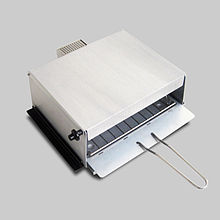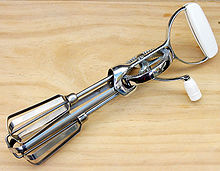Home appliance
A household appliance is a mechanical or electrical device that is commonly used in private households . This includes, for example, kitchen appliances or vacuum cleaners . In retail , the range of kitchen appliances is referred to as white goods . This includes large appliances such as washing machines or dishwashers and small electrical appliances.
Consumer electronics (for example TVs , DVD recorders or PCs ), which used to be referred to as brown goods in the trade , are now regarded as a separate device area and no longer counted as household appliances, the same applies to do-it-yourself devices and toys ( model railways , Game Boy ). A clear line cannot be drawn for do-it-yourself tools; an orbital sander, for example, will hardly be counted as a household appliance, whereas a cordless drill will .
domestic appliances

Household appliances include:
- Laundry Care Appliances: washing machine , dryer , deficiency , iron
- Kitchen appliances: appliances for
- Cooking and baking: stove , oven , microwave oven , mini oven with grill , pressure cooker , cooking machine (historically 19th century) - also for wood or coal firing or gas appliances
- Rinse: dishwasher
- Cooling and freezing: fridge , freezer , fridge -freezer, as well
- Small electrical appliances: hand mixer , coffee maker , espresso machine , food processor , hand blender , juicer , toaster , kettle , electric grill
- mechanical devices: manual can opener , Flotte Lotte , Minna (food processor) , floor or table cleaner, kitchen scales
- simple kitchen utensils such as cutlery , pots and kitchen textiles.
- Room air conditioners : fan , fan heater , humidifier , dehumidifier , air conditioning
- Cleaning equipment: vacuum cleaner, floor polisher , wet-dry vacuum cleaner
- Lighting devices: floor lamp, desk lamp
- Personal care equipment: hairdryer , curling iron
- Heat generator: heating pad , radiant heater , sun bed
- Do-it-yourself machines : sewing machine , cordless drill
- Meters: bathroom scales , digital thermometer
Historical development of household electrical appliances
The development of household appliances used today goes hand in hand with the development of the supply of electricity . The first hydropower plants with their power grids built at the turn of the 19th to the 20th century were only sufficient to operate arc and incandescent lamps . The electricity price to be paid was considerable and exceeded the hourly wage of a skilled worker per kilowatt hour .
Only after the First World War did the situation change with the construction of the first large steam power plants . At the same time, the high-voltage network was expanded, with which the converted thermal energy could be transmitted over long distances. In the household, this development meant the massive use of the electric iron, the first electric household appliance alongside the electric sewing machine. Their successful market launch in the 19th century ushered in the industrialization of private households.
About 15 years later, the use of the radio was propagated by the National Socialists , and with the so-called Volksempfänger the rulers at the time obtained an extraordinarily popular instrument for spreading their propaganda . The attempted introduction of the electric refrigerator at this time, however, fails because of the purchase price for this device.
After the Second World War , the currency reform and the economic miracle , the power plants and the electricity grids are becoming more and more efficient while electricity prices are falling. At the same time, more electrical household appliances are entering the market . The electric stove , electric washing machine, the dishwasher , vacuum cleaner, television and many other instruments of consumer electronics establish themselves in the household sector. Ten years later, the electric coffee maker and freezer were added, and after another 15 years the microwave oven. Some of these devices were invented decades before their widespread market launch; their market success at the time of the invention was prevented time and again by the lack of access to inexpensive electricity.
Nowadays the trend continues towards "networked home appliances", mostly via powerline solutions. Siemens is developing serve @ Home, Miele has Miele @ home products and in Switzerland you can find ZUG-Home from V-Zug AG . The goal is always to increase the added value in the use of the device and to create new (remote) control options.
Household appliances such as refrigerators, vacuum cleaners and dishwashers resulted in considerable time savings: in the USA, for example, in 1900 washing, cooking and cleaning alone required almost 60 hours a week per household, four times as much as today.
Energy efficiency of large devices
When operating large electrical household appliances, more attention is paid to energy efficiency in order to reduce the associated environmental impact, but also costs. As an auxiliary tool for consumer energy consumption labels are on the sale of home appliances over a certain size, EU energy label to be used. In stationary retail, appropriate labels, which are usually supplied by the manufacturer with the products, must be attached to the products. In online trading, the display of the product is mandatory.
The EU energy label rates the electricity and water consumption in relation to the device function with a gradation from A (economical) to G (wasteful). Today (2012) mostly only devices of class A are offered on the market, so that the grading criteria of the EU label are technically obsolete. Classes A +, A ++ and A +++, introduced in 2004, correspond to the current state of the art only for refrigerators and freezers. Since July 2012, only cooling devices with the minimum energy efficiency class A + can be sold in the EU. An up-to-date evaluation can be found in the regularly updated list of economical household appliances that are used for B. is offered by energy consultants and city administrations. The German Energy Efficiency Initiative (DENEFF), the Federation for Environment and Nature Conservation (BUND) and the Federal Association for Renewable Energies (BEE) have issued a joint declaration in favor of a scrapping premium for household appliances that consume a lot of electricity.
See also
literature
- Martina Heßler : The Introduction of Electrical Household Appliances in the Interwar Period - The Supply Push by Producers and the Reaction of Consumers . In: Technikgeschichte , Volume 65 (1998), H. 4, pp. 297-311.
Web links
- Wholesale catalog of housewares from 1938
- Brochure “Particularly economical household appliances” on the website of the consumer advice center for energy advice
Individual evidence
- ↑ Everything used to be worse - household appliances . In: Der Spiegel . No. 15 , 2016 ( online ).
- ↑ New EU regulation for cooling device efficiency . ( Memento of the original from November 30, 2013 in the Internet Archive ) Info: The archive link was automatically inserted and not yet checked. Please check the original and archive link according to the instructions and then remove this notice. Retrieved October 17, 2012.
- ↑ Associations demand scrapping premium for household appliances. Accessed July 20, 2015.


